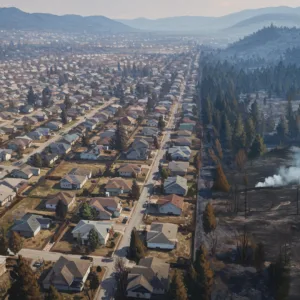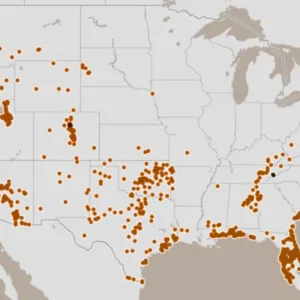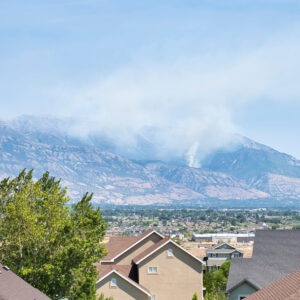
Likewise, “assuming a firefighter can protect our home is no longer a safe or responsible expectation to have,” says Kimiko Barrett, a wildfire resilience researcher at Headwaters Economics, an independent, nonpartisan research group.

Born and raised in Montana, Dr. Kimiko Barrett (Kimi) has a deep interest in rural landscapes and the people who live there. She has a natural aptitude for connecting and energizing people in the pursuit of community resilience and climate adaptation.
Kimi is a committed agent of change in how we live with inevitable wildfires. Drawing on the expertise within the broad networks she has built, she has led research of national significance on topical issues such as the true cost of wildfires, the cost of building wildfire-resistant homes, and measuring wildfire impacts through structure loss. Her work has changed the national wildfire narrative and shaped new strategies for engaging communities on wildfire resilience.
Kimi managed Headwaters Economics’ Community Planning Assistance for Wildfire program for six years. In that capacity she worked with firefighters, land use and planning staff, government agency personnel, and elected officials in more than 80 communities across the country, helping them devise community-driven solutions to reduce wildfire risk and increase community adaptation efforts. Kimi’s experience with local-level efforts ensures that her research and policy work addresses real problems on the ground.
Uniquely positioned in the nexus of communities, science, and natural hazards, Kimi is regularly quoted by major media outlets. She is frequently interviewed by the New York Times, LA Times, Bloomberg, and Washington Post, National Public Radio, The Economist, the Associated Press, and Marketplace. And because of Kimi’s outstanding ability to engage diverse audiences, she is a sought-after speaker, regularly presenting at professional trainings, university seminars, community workshops, conferences, and congressional hearings. Kimi was recently appointed, served, and led efforts as a member of the Federal Wildland Fire Mitigation and Management Commission.
Kimi has had a lifelong interest in community cultures, social change, and science. Her professional career and her exceptional communication skills are built on the groundwork of academic degrees in political science and Japanese, forestry, and geography.
Federal wildfire policy that emphasizes suppression—a legacy of early-1900s forest management—has resulted in a paradox: accumulated fuels and larger, more severe wildfires.
Land use planning can help communities become fire-adapted and resilient in the face of increasing wildfire potential.
Managing wildfires during a pandemic will test the capacity of our first responders, but individual homeowners can take steps now to reduce wildfire risks.
Community Planning Assistance for Wildfire (CPAW) is helping communities reduce wildfire risks and costs. Four new communities join 26 others this coming year.
Almost half of the full community costs of wildfire are paid for at the local level, including homeowners, businesses, and government agencies.
The wildfires that burned the edge of the Great Smoky Mountains National Park devastated nearby communities and underscore the need to reduce the risks and costs of future catastrophic events.
Mapping and understanding communities at risk from wildfires just became easier with a new interactive tool generated by Headwaters Economics.
Five urban areas in the West and Southwest are taking steps to mitigate wildfire risks and costs through the perspective of land use planning.
Case studies show how five urban areas in the West are using innovative land use planning tools to adapt to the increasing risks from wildfires.

Upfront investments in rebuilding to wildfire-resistant standards can save billions in future avoided economic losses.

More than 1,100 communities in 32 states face similar risks to Los Angeles and other places with recent urban wildfires, highlighting the urgent need for wildfire-resistant homes and neighborhoods.

An independent analysis by Headwaters Economics shows that the first round of funding from the Community Wildfire Defense Grant program prioritized high-risk, low-income communities.

In this video produced by Headwaters Economics, homeowner Brodey Simkins describes the tragedy of losing his home to wildfire and his commitment to rebuilding with wildfire in mind.

Kimiko Barrett of Headwaters Economics in Bozeman, Montana, who worked with counties in the state to secure Community Wildfire Defense Grants, said grant recipients were told Monday that payments had been paused for at least 10 days.
“Coming out of Los Angeles, we have learned that this is a crisis involving very specific risk reduction efforts,” Barrett said. “Without this program communities will not have the tools to continue the very important mitigation work that’s needed.”

“If your neighbor doesn’t do anything, and you do, if that home burns it will create so much radiant heat, yours will burn too,” said Kimiko Barrett of Headwaters Economics in Bozeman, Mont., a company that advises cities on reducing wildfire damage risk. Neighbors matter.

Kimiko Barrett, senior wildfire research and policy analyst at the research institute Headwaters Economics, said there are three ways homes ignite during a wildfire: direct flame contact from the fire front, radiant heat from nearby items catching fire, or ember exposure.